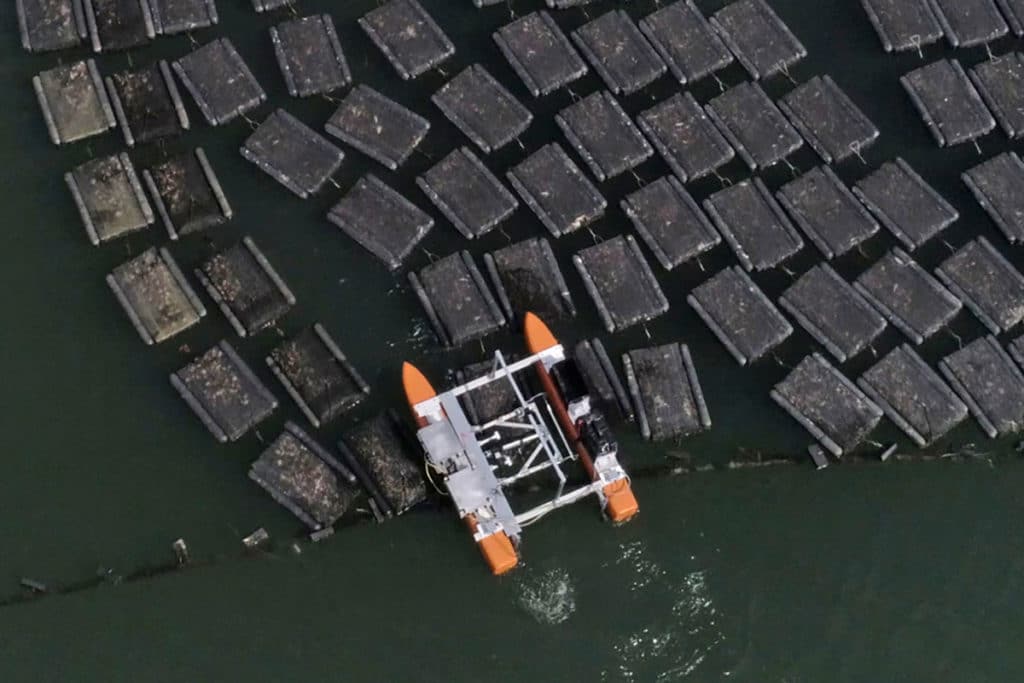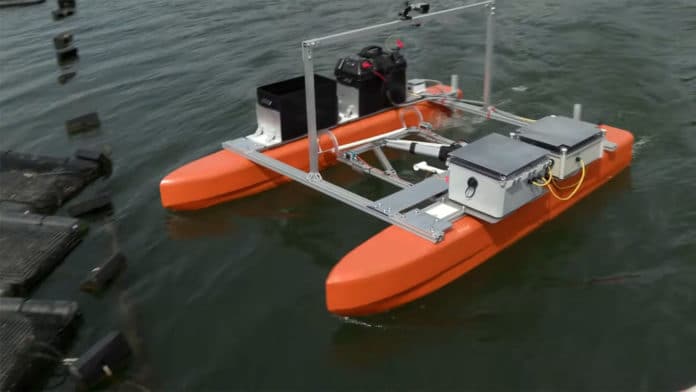MIT students and researchers are working directly with local oyster farmers in advancing the aquaculture industry by seeking solutions to some of its biggest challenges. Currently, heavy oyster bags have to be manually flipped every one to two weeks to reduce biofouling.
To make this job easier, the MIT students are developing a robot that can flip heavy, floating bags of oysters, helping the shellfish to grow and stay healthy. The “Oystamaran” is a catamaran with a flipping mechanism between its two hulls.
The MIT project began when Dan Ward, a seasoned oyster farmer and marine biologist – who owns the Ward Aquafarms oyster-farming company in Cape Cod – told Prof. Michael Triantafyllou that how each of his thousands of floating mesh oyster bags needs to be turned over about 11 times a year. The flipping allows algae, barnacles, and other “biofouling” organisms that grow on the part of the bag beneath the water’s surface to be exposed to air and light, so they can dry and chip off. If this task is not performed, water flow to the oysters, which is necessary for their growth, is blocked.

The bags are flipped by a farmworker in a kayak, and the task is monotonous, often performed in rough water and bad weather, and ergonomically injurious. “It’s kind of awful, generally speaking,” says Ward adding that he pays about $3,500 per year to have the bags turned over at each of his two farm sites – and struggles to find workers who want to do the job of flipping bags that can grow to a weight of 60 or 70 pounds just before the oysters are harvested.
Seeking a less labor-intensive alternative, the MIT team created the Oystamaran electric catamaran. The device starts by straddling a bag between its pontoons and then uses a hooked robotic arm to reach down and grasp the float on one side of the bag. After that, it pulls that arm back up and to the other side, lifting and flipping the bag in the process. The Oystamaran robot uses a vision system to position and flip the bags.
Michelle Kornberg, who had constructed the original central flipping mechanism and the basic structure of the vessel as a staff member at MIT Sea Grant after graduating in May 2020, worked as a lab instructor for the next capstone class related to the project in spring 2021. Andrew Bennett, an education administrator at MIT Sea Grant, co-taught that class, in which students designed an Oystamaran version 2.0, which was tested at Ward Aquafarms and managed to flip several rows of bags while being controlled remotely.
The next steps will involve making the vessel more autonomous, so it can be launched, navigate autonomously to the oyster bags, flip them, and return to the launching point. A third capstone class related to the project will take place this spring.
Prof. Triantafyllou calls the Oystamaran “a first for the industry,” explaining that the project has demonstrated that robots can perform extremely useful tasks in the ocean and will serve as a model for future innovations in aquaculture. “Just by showing the way, this may be the first of a number of robots,” he says. “It will attract talent to ocean farming, which is a great challenge, and also a benefit for society to have a reliable means of producing food from the ocean.”
